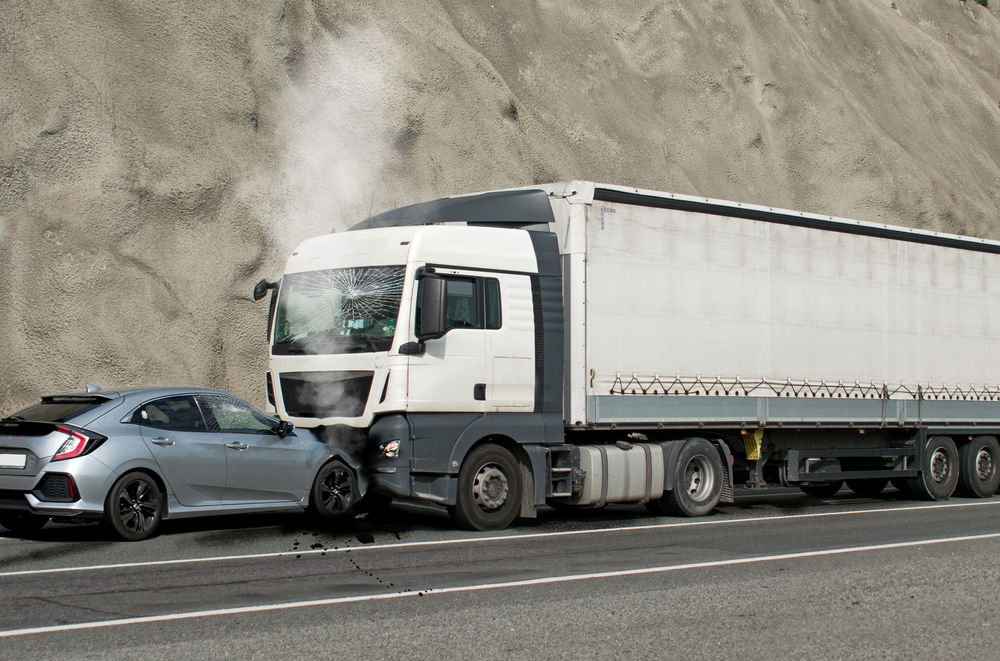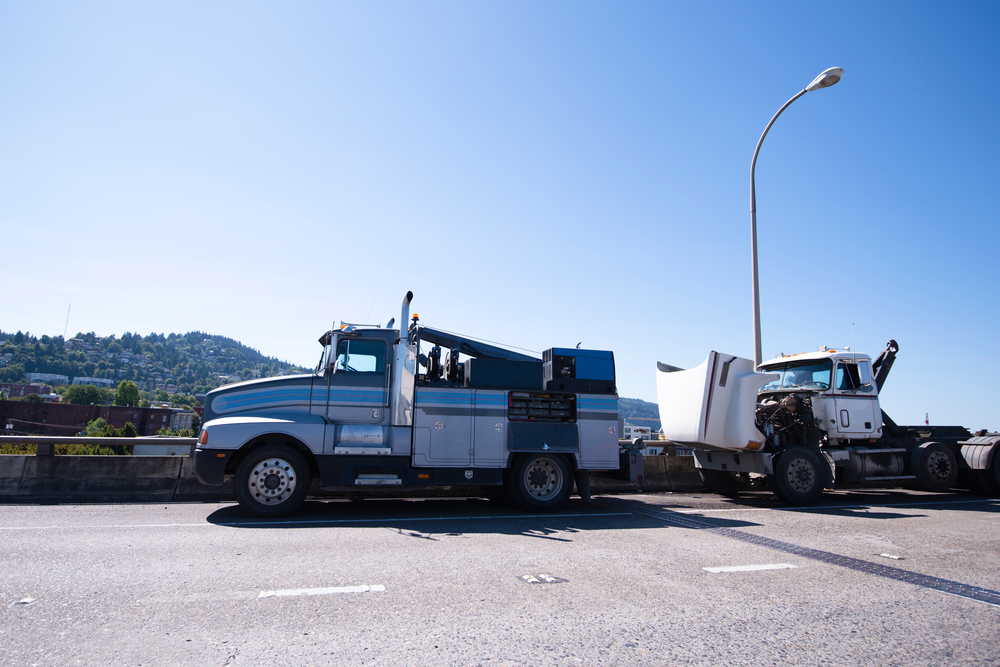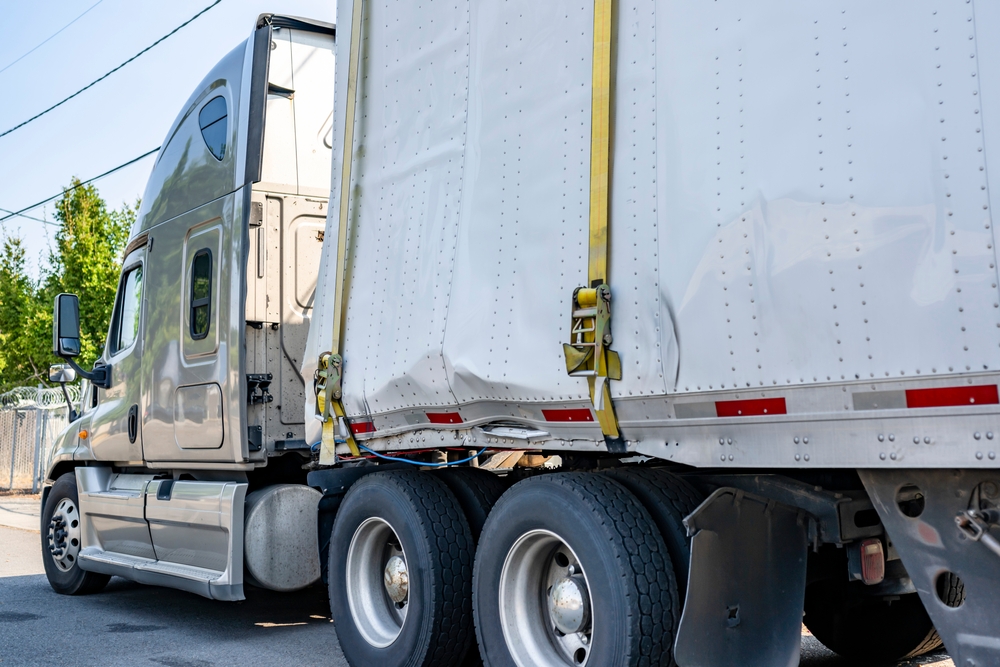If you’re injured in a truck accident where the fault is not your own (or only partially your own) then you could be eligible for compensation. The other side’s insurance company will most likely try to settle with you, providing you with a lump sum. Almost invariably, this will be less than what your case is worth.

If you’ve been involved in a truck accident, it’s important to know that you have the right to claim both economic and non-economic damages, as part of your compensation package. Such compensation aims to alleviate the financial and emotional burden that’s often associated with these unfortunate incidents.
Let’s start by exploring economic damages. These encompass reimbursement for any monetary expenses you’ve had to bear as a result of your accident. It’s not just limited to the direct costs associated with the accident, such as hospital bills or the ambulance charges. It also includes any therapy or counseling you might require to help you cope with the trauma, or any other form of treatment necessary to aid your recovery process.
Damages You Can Claim
Added to this, you could be compensated for any income you’ve lost due to your inability to work in the aftermath of the accident. In the event you’re permanently disabled and unable to return to work, you’re entitled to receive the projected income you would have earned during your working years. Moreover, compensation to repair or replace your damaged vehicle is also part of economic damages. For extreme, life-altering injuries that require modifications to your living environment or in-home care, financial provision may be made available as well.

Apart from these tangible costs, you can also claim non-economic damages. These cover the intangible, subjective costs related to your accident. This includes compensation for the pain and suffering you may have endured, the emotional distress and anxiety you’ve experienced, and any disfigurement or physical impairments. Even the loss of the quality of your life or the loss of consortium, which is the companionship of your spouse, are considered non-economic damages.
These unfortunate incidents have far-reaching consequences that affect not just your physical well-being, but your emotional and mental health as well. That’s why we’re here for you, committed to represent you adamantly to ensure you receive everything you’re rightfully owed. By assessing both your economic and non-economic losses, we aim to provide comprehensive representation that will seek to ease your burden in this difficult time.

To schedule a free case evaluation and see what your claim is worth, call or message Belal Hamideh, an experienced semi truck accident lawyer.
California Truck Accident Laws
The following laws may pertain to your case. For more information or if you have further questions, contact Belal Hamideh for a free case evaluation.
California Code, Vehicle Code – VEH § 17150
Every owner of a motor vehicle is liable and responsible for death or injury to person or property resulting from a negligent or wrongful act or omission in the operation of the motor vehicle, in the business of the owner or otherwise, by any person using or operating the same with the permission, express or implied, of the owner.
California Code, Vehicle Code – VEH § 17300
(a) A person who willfully or negligently damages a street or highway, or its appurtenances, including, but not limited to, guardrails, signs, traffic signals, snow poles, and similar facilities, is liable for the reasonable cost of repair or replacement thereof.
(b) A person who willfully damages or destroys a memorial sign placed by the Department of Transportation, including, but not limited to, a sign memorializing a victim under Section 101.10 of the Streets and Highways Code, is liable for that damage or destruction for the highest of the following amounts:
(1) One thousand five hundred dollars ($1,500).
(2) The actual repair cost or replacement cost, whichever is applicable.
(c) A person who willfully or negligently causes or permits the contents of a vehicle to be deposited upon a street or highway, or its appurtenances, is liable for the reasonable costs of removing those contents from the street or highway or its appurtenances.
(d) The liability stated in this section also applies to an owner of a vehicle operated with the owner’s permission, as provided in Article 2 (commencing with Section 17150), and includes liability for the reasonable cost of necessary safety precautions, including, but not limited to, warning traffic, the removal of debris resulting from accidents, the removal of any materials, or providing detours.
(e) The Department of Transportation and local authorities, with respect to highways under their respective jurisdictions, may present claims for liability under this section, bring actions for recovery thereon, and settle and compromise, in their discretion, claims arising under this section.
(f) If the Department of Transportation or a local authority provides services on a highway outside its jurisdiction, at the request of the department or the local authority that has jurisdiction over that highway, the department or the local authority may present a claim for liability for rendering this service under this section, bring actions for recovery thereon, and, in its discretion, settle and compromise the claim.
California Code, Vehicle Code – VEH § 17301
(a) Any person driving any vehicle, object, or contrivance over a highway or bridge is liable for all damages which the highway or bridge may sustain as a result of any illegal operation, driving or moving of the vehicle, object, or contrivance, or as a result of operating, driving, or moving any vehicle, object, or contrivance weighing in excess of the maximum weight specified in this code which is operated under a special permit issued by the Department ofTransportation.
(b) Whenever the driver is not the owner of the vehicle, object, or contrivance but is operating, driving, or moving the same with the express or implied permission of the owner, the owner and driver are jointly and severally liable for the damage.
California Code, Vehicle Code – VEH § 17301
(a) Any person driving any vehicle, object, or contrivance over a highway or bridge is liable for all damages which the highway or bridge may sustain as a result of any illegal operation, driving or moving of the vehicle, object, or contrivance, or as a result of operating, driving, or moving any vehicle, object, or contrivance weighing in excess of the maximum weight specified in this code which is operated under a special permit issued by the Department ofTransportation.
(b) Whenever the driver is not the owner of the vehicle, object, or contrivance but is operating, driving, or moving the same with the express or implied permission of the owner, the owner and driver are jointly and severally liable for the damage.
California Code, Vehicle Code – VEH § 20003
(a) The driver of any vehicle involved in an accident resulting in injury to or death of any person shall also give his or her name, current residence address, the names and current residence addresses of any occupant of the driver’s vehicle injured in the accident, the registration number of the vehicle he or she is driving, and the name and current residence address of the owner to the person struck or the driver or occupants of any vehicle collided with, and shall give the information to any traffic or police officer at the scene of the accident. The driver also shall render to any person injured in the accident reasonable assistance, including transporting, or making arrangements for transporting, any injured person to a physician, surgeon, or hospital for medical or surgical treatment if it is apparent that treatment is necessary or if that transportation is requested by any injured person.
(b) Any driver or injured occupant of a driver’s vehicle subject to the provisions of subdivision (a) shall also, upon being requested, exhibit his or her driver’s license, if available, or, in the case of an injured occupant, any other available identification, to the person struck or to the driver or occupants of any vehicle collided with, and to any traffic or police officer at the scene of the accident.
California Code, Vehicle Code – VEH § 20004
In the event of death of any person resulting from an accident, the driver of any vehicle involved after fulfilling the requirements of this division, and if there be no traffic or police officer at the scene of the accident to whom to give the information required by Section 20003, shall, without delay, report the accident to the nearest office of the Department of the California Highway Patrol or office of a duly authorized police authority and submit with the report the information required by Section 20003.
California Code, Vehicle Code – VEH § 34620
(a) Except as provided in subdivision (b) and Section 34622, a motor carrier of property shall not operate a commercial motor vehicle on any public highway in this state, unless it has complied with Section 34507.5 and has registered with the department its carrier identification number authorized or assigned thereunder, and holds a valid motor carrier permit issued to that motor carrier by the department. The department shall issue a motor carrier permit upon the carrier’s written request, compliance with Sections 34507.5, 34630, and 34640, and subdivisions (e) and (h) of Section 34501.12 for motor carriers listed in that section, and the payment of the fee required by this chapter.
(b) A person shall not contract with, or otherwise engage the services of, a motor carrier of property, unless that motor carrier holds a valid motor carrier of property permit issued by the department. A motor carrier of property or broker of construction trucking services, as defined in Section 3322 of the Civil Code, shall not contract or subcontract with, or otherwise engage the services of, a motor carrier of property, until the contracted motor carrier of property provides certification in the manner prescribed by this section, of compliance with subdivision (a). This certification shall be completed by the contracted motor carrier of property and shall include a provision requiring the contracted motor carrier of property to immediately notify the person to whom they are contracted if the contracted motor carrier of property’s permit is suspended or revoked. A copy of the contracted motor carrier of property’s permit shall accompany the required certificate. The Department of the California Highway Patrol shall, by regulation, prescribe the format for the certificate and may make available an optional specific form for that purpose. The certificate, or a copy thereof, shall be maintained by each involved party for the duration of the contract or period of service plus two years, and shall be presented for inspection at the location designated by each carrier under Section 34501.10, immediately upon the request of an authorized employee of the Department of the California Highway Patrol.
(c)(1) A motor carrier of property shall not retrieve a vehicle through the use of a tow truck, as defined in subdivision (a) of Section 615, from the premises of another motor carrier of property until the retrieving motor carrier provides a copy of its motor carrier permit to the releasing motor carrier.
(2) A motor carrier of property shall not release a vehicle to another motor carrier of property utilizing a tow truck, as defined in subdivision (a) of Section 615, until the releasing motor carrier obtains a copy of the motor carrier permit from the retrieving motor carrier. The motor carrier releasing the vehicle shall maintain a copy of the motor carrier permit for a period of two years after the transaction, and, upon the request of an authorized employee of the Department of the California Highway Patrol, shall immediately present the permit for inspection at the location designated by the releasing motor carrier under Section 34501.10.
(3) This subdivision does not apply to a person licensed pursuant to the Collateral Recovery Act (Chapter 11 (commencing with Section 7500) of Division 3 of the Business and Professions Code).
California Code, Code of Civil Procedure – CCP § 335.1
Within two years: An action for assault, battery, or injury to, or for the death of, an individual caused by the wrongful act or neglect of another.
California Code, Code of Civil Procedure – CCP § 338
Within three years:
(a) An action upon a liability created by statute, other than a penalty or forfeiture.
(b) An action for trespass upon or injury to real property.
(c)(1) An action for taking, detaining, or injuring goods or chattels, including an action for the specific recovery of personal property.
(2) The cause of action in the case of theft, as described in Section 484 of the Penal Code, of an article of historical, interpretive, scientific, or artistic significance is not deemed to have accrued until the discovery of the whereabouts of the article by the aggrieved party, the aggrieved party’s agent, or the law enforcement agency that originally investigated the theft.
(3)(A) Notwithstanding paragraphs (1) and (2), an action for the specific recovery of a work of fine art brought against a museum, gallery, auctioneer, or dealer, in the case of an unlawful taking or theft, as described in Section 484 of the Penal Code, of a work of fine art, including a taking or theft by means of fraud or duress, shall be commenced within six years of the actual discovery by the claimant or the claimant’s agent, of both of the following:
(i) The identity and the whereabouts of the work of fine art. In the case where there is a possibility of misidentification of the object of fine art in question, the identity can be satisfied by the identification of facts sufficient to determine that the work of fine art is likely to be the work of fine art that was unlawfully taken or stolen.
(ii) Information or facts that are sufficient to indicate that the claimant has a claim for a possessory interest in the work of fine art that was unlawfully taken or stolen.
(B) This paragraph shall apply to all pending and future actions commenced on or before December 31, 2017, including an action dismissed based on the expiration of statutes of limitations in effect prior to the date of enactment of this statute if the judgment in that action is not yet final or if the time for filing an appeal from a decision on that action has not expired, provided that the action concerns a work of fine art that was taken within 100 years prior to the date of enactment of this statute.
(C) For purposes of this paragraph:
(i) “Actual discovery,” notwithstanding Section 19 of the Civil Code, does not include constructive knowledge imputed by law.
(ii) “Auctioneer” means an individual who is engaged in, or who by advertising or otherwise holds the individual out as being available to engage in, the calling for, the recognition of, and the acceptance of, offers for the purchase of goods at an auction as defined in subdivision (b) of Section 1812.601 of the Civil Code.
(iii) “Dealer” means a person who holds a valid seller’s permit and who is actively and principally engaged in, or conducting the business of, selling works of fine art.
(iv) “Duress” means a threat of force, violence, danger, or retribution against an owner of the work of fine art in question, or the owner’s family member, sufficient to coerce a reasonable person of ordinary susceptibilities to perform an act that otherwise would not have been performed or to acquiesce to an act to which the person would otherwise not have acquiesced.
(v) “Fine art” has the same meaning as defined in paragraph (1) of subdivision (d) of Section 982 of the Civil Code.
(vi) “Museum or gallery” shall include any public or private organization or foundation operating as a museum or gallery.
(4) Section 361 shall not apply to an action brought pursuant to paragraph (3).
(5) A party in an action to which paragraph (3) applies may raise all equitable and legal affirmative defenses and doctrines, including, without limitation, laches and unclean hands.
(d) An action for relief on the ground of fraud or mistake. The cause of action in that case is not deemed to have accrued until the discovery, by the aggrieved party, of the facts constituting the fraud or mistake.
(e) An action upon a bond of a public official except any cause of action based on fraud or embezzlement is not deemed to have accrued until the discovery, by the aggrieved party or the aggrieved party’s agent, of the facts constituting the cause of action upon the bond.
(f)(1) An action against a notary public on the notary public’s bond or in the notary public’s official capacity except that a cause of action based on malfeasance or misfeasance is not deemed to have accrued until discovery, by the aggrieved party or the aggrieved party’s agent, of the facts constituting the cause of action.
(2) Notwithstanding paragraph (1), an action based on malfeasance or misfeasance shall be commenced within one year from discovery, by the aggrieved party or the aggrieved party’s agent, of the facts constituting the cause of action or within three years from the performance of the notarial act giving rise to the action, whichever is later.
(3) Notwithstanding paragraph (1), an action against a notary public on the notary public’s bond or in the notary public’s official capacity shall be commenced within six years.
(g) An action for slander of title to real property.
(h) An action commenced under Section 17536 of the Business and Professions Code. The cause of action in that case shall not be deemed to have accrued until the discovery by the aggrieved party, the Attorney General, the district attorney, the county counsel, the city prosecutor, or the city attorney of the facts constituting grounds for commencing the action.
(i) An action commenced under the Porter-Cologne Water Quality Control Act (Division 7 (commencing with Section 13000) of the Water Code). The cause of action in that case shall not be deemed to have accrued until the discovery by the State Water Resources Control Board or a regional water quality control board of the facts constituting grounds for commencing actions under their jurisdiction.
(j) An action to recover for physical damage to private property under Section 19 of Article I of the California Constitution.
(k) An action commenced under Division 26 (commencing with Section 39000) of the Health and Safety Code. These causes of action shall not be deemed to have accrued until the discovery by the State Air Resources Board or by a district, as defined in Section 39025 of the Health and Safety Code, of the facts constituting grounds for commencing the action under its jurisdiction.
(l) An action commenced under Section 1602, 1615, or 5650.1 of the Fish and Game Code. These causes of action shall not be deemed to have accrued until discovery by the agency bringing the action of the facts constituting the grounds for commencing the action.
(m) An action challenging the validity of the levy upon a parcel of a special tax levied by a local agency on a per parcel basis.
(n) An action commencing under Section 51.7 of the Civil Code.
(o) An action commenced under Section 4601.1 of the Public Resources Code, if the underlying violation is of Section 4571, 4581, or 4621 of the Public Resources Code, or of Section 1103.1 of Title 14 of the California Code of Regulations, and the underlying violation is related to the conversion of timberland to nonforestry-related agricultural uses. These causes of action shall not be deemed to have accrued until discovery by the Department of Forestry and Fire Protection.
(p) An action for civil penalties commenced under Section 26038 of the Business and Professions Code.
